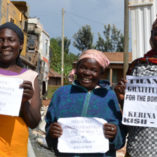Blog
In Search Of Clean Drinkable Water
Day in and day out, many of us enjoy the privilege and convenience of turning on a tap, then outflows what we know as, clean, drinkable water.
Then, we can do with it what we please; drink it, bathe in it, cook with it, even play in it and with it.
Each morning when many of us rise imbued with assurance that we can shower or bath for ten to fifteen minutes; cleanse and rejuvenate. During this time we enjoy the free flow of water, and it may never occur to some of us, what if I should wake up one morning and life switches; only then to realize that I can no longer take that luxurious bath or shower or that I cannot start my day with that clean glass of water, and to top that, I must now walk for 10 hours round trip to a dam, to fetch water.
Then after an unrelentingly hot journey, to arrive at the dam and greeted by crocodiles swimming in the water, rearing their heads looking for a meal. Isn’t it enough that I travelled that long journey by foot to get water? *This happens to be my only source of water, unfortunately from a dam that crocodiles’ habitate. I’m horrified by the smell, and I fear for my life, but I must have water! I need water! Clean water. Still, I’m grateful and hopeful. When my neck and my back aches from the many trips of carrying water on my head and in my arms, I question, again and again, is this my reality? or is it a dream.
- “Over 13 million Kenyans lack access to an improved water supply, sanitation, and hygiene
- according to health survey-2014. (WASH)-related diseases and associated conditions (e.g. anemia, dehydration, typhoid, dysentery, and malnutrition) are the number one cause of under-5 hospitalizations and mortality.
- Over 50% of hospital visits in Kenya for illnesses are related to waterborne diseases, or conditions. Although Kenya has recently launched broad reform and stepped up investment in water and sanitation, the country still faces considerable challenges in reaching the just ended UN water and sanitation MDGs blueprint.
WATER RELATED CHALLENGES and CONCERNS FACING WOMEN
- Skeletal deformity and back pain which is due repeatedly carrying water containers to and from the water source for longer distance.
- Miscarriage for pregnant mother/women due to weight exerted by a regularly use 20-liter water container.
- An occasional isolated instance of rape of a girl who falls prey to criminals while fetching water for their family from a faraway water source.
- School girls use most of their class time in fetching water for their family.
- The unhygienic living condition for many women and their family leads to diseases”.
Bringing it home to Canada-which has an abundant water supply, yet, did you know that water in many indigenous communities in Ontario is not safe to drink? (Human Rights Watch stated). Many First Nations communities in Canada depend on water that is contaminated, challenging to access or considered toxic due to faulty treatment systems.
There is a crisis near and far, different scenarios and impact.
Comments are closed




